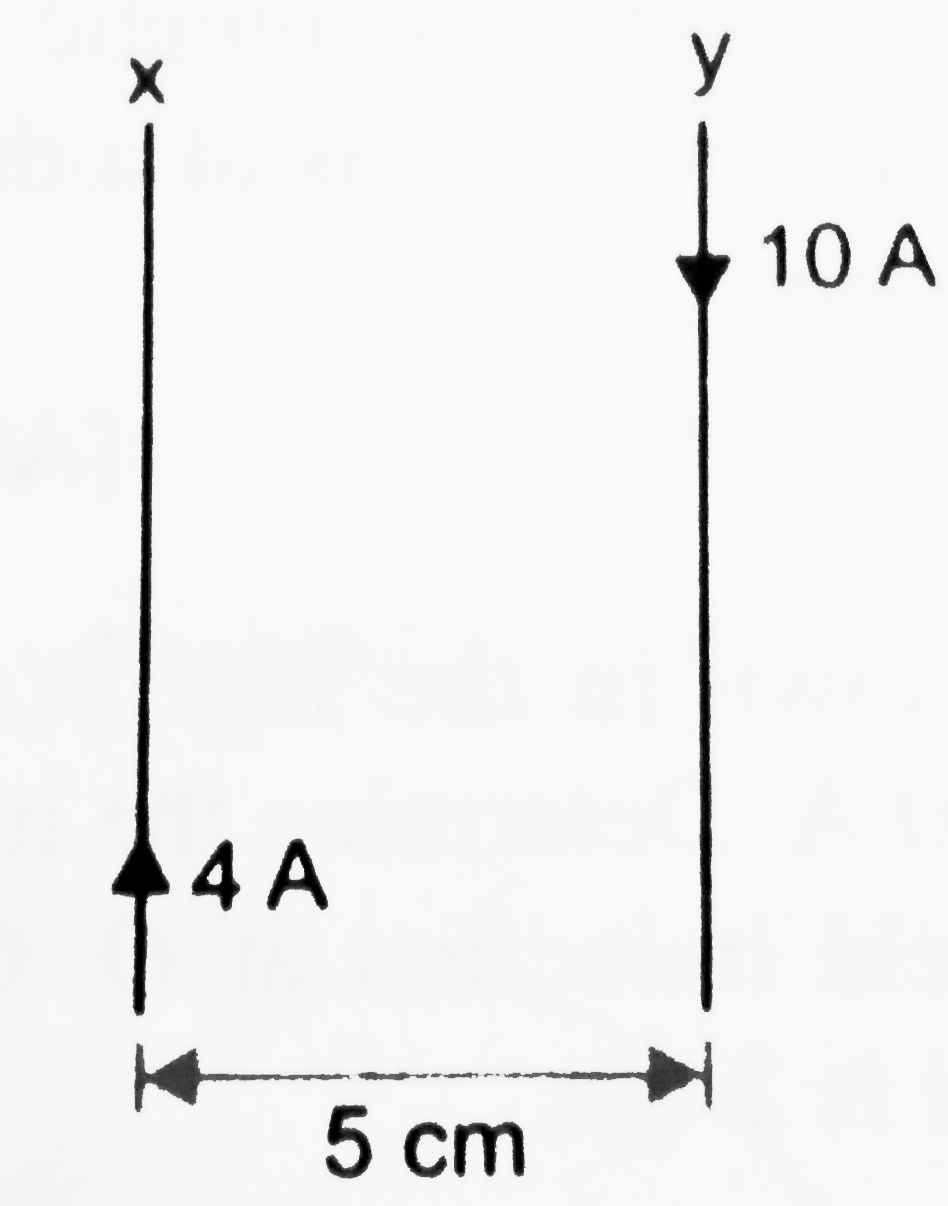Two parallel wires P and Q placed at a separation d =6 cm on x-axis carry electric current i1=5Aandi2=2A in opposite directions as shown in Fig. Find the point on the line PQ where the resultant mgnetic field is zero.

4 cm left P
4 cm right of Q
middle of PQ
At no position
The correct Answer is:B
At the desired point, the magnetic field due to two wires must have equal magnitude but opposite directions. The point should be either to the left of P or to the right of Q. As the wire Q has smaller current, hte point should be closer to Q. Let this point R be at a distance x form Q.
The magnetic field at R due to the current i1 will have magnitude.
(B1)=μ0i12π(d+x)
and will be directed in the plane of the figure. The field at the same point due to the current (i2) will be
B2=μ0i22πx
directed upward in the plane of the figure. If the resultant field at R is zero, we should have B1=B2, so that i1d+x=i2x
Hence, x=i2di1−i2=(2A)(6cm)(3A)=4cm.
Topper's Solved these Questions
- MISCELLANEOUS VOLUME 5Book:CENGAGE PHYSICSChapter:MISCELLANEOUS VOLUME 5Exercise:Multiple Correct
Explore 34 Videos
- MISCELLANEOUS VOLUME 5Book:CENGAGE PHYSICSChapter:MISCELLANEOUS VOLUME 5Exercise:Linked Comprehension
Explore 84 Videos
- MISCELLANEOUS VOLUME 3Book:CENGAGE PHYSICSChapter:MISCELLANEOUS VOLUME 3Exercise:True and False
Explore 3 Videos
- Moving charges and magnetismBook:CENGAGE PHYSICSChapter:Moving charges and magnetismExercise:Question Bank
Explore 20 Videos
Similar Questions
Two parallel wires P and Q placed at a separation
d=6cmcarrye≤ctriccurrentsi1=5Aandi2=2A∈
oppositedirectionsasshown∈figure.F∈dthe
p∮onthel∈ePQwheretherestant–––––mag≠ticfield
is zero.

View SolutionTwo parallel wires C and D placed perpendicular to the plane of paper at a separation of r(=8cm), carry electric currents I1=6A and I2=3A in opposite directions as shown in figure. Find the point on the line CD where the resultant magnetic field is zero.

View Solution
Knowledge Check
Two very long, straight wires carrying, currents as shown in Fig. Find all locations where the net magnetic field is zero.
 Ay=√2xBy=xCy=−xDy=−(x2)
Ay=√2xBy=xCy=−xDy=−(x2)Two coplanar circular coils of equal radius carrying currents i1,i2 in opposite directions are at a large distance 'd'. The distance from the first coil where the resultant magnetic induction is zero is
Ad1+i2i1Bd1+√i2i1Cd1+(i2i1)13Dd1+(i2i1)2Two parallel wires carrying currents I1 and I2 in opposite directions and separated by a distance d experience a
Arepulsive force μ0I1I2/2πdBattractive force μ0I1I2/2πdCrepulsive force μ0I1I2/2πd2Dattractive force μ0I1I2/2πd2
Two parallel wires P and Q placed distance r apart. They are carrying currents I1 and I2 where I1>I2, but in opposite directions as shown in figure. Find the point on the line PQ where the resultant magnetic field is zero.

View SolutionThere are two parallel current carrying wires X and Y as shown in figure. Find the distance of a point from wire X, where the resultant magnetic field is zero.

View SolutionFigure shows two long parallel straight wires distance 5cm apart carrying currents 4A and 10A in opposite directions. Find the position of a point where the resultant magnetic field due to current in two wires in zero.

View SolutionTwo long and parallel wires at P and Q carry currents 0. 1A and 0.2A respectively in opposite directions as shown in figure-4.239. In which region(s) a neutral point may not exist, that is where the magnetic field is not zero?

View SolutionElectric currents I1 and I2 are flowing in two mutually perpendicular conductors as shown in figure. Find the equation of locus of zero magnetic field points.

View Solution

